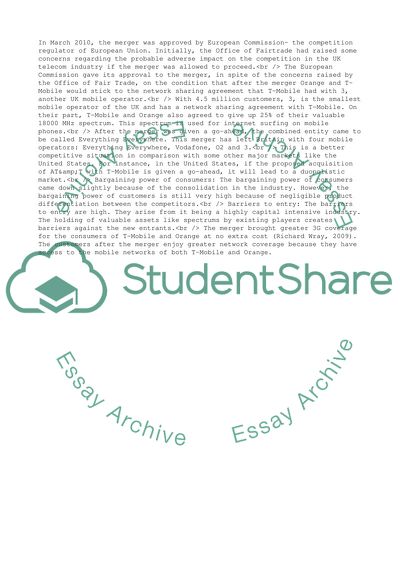Cite this document
(The Merger of T-Mobile and Orange Case Study Example | Topics and Well Written Essays - 2000 words, n.d.)
The Merger of T-Mobile and Orange Case Study Example | Topics and Well Written Essays - 2000 words. Retrieved from https://studentshare.org/business/1752867-from-a-competition-policy-viewpoint-consider-whether-the-merger-between-orange-and-t-mobile-should-have-been-permitted-also-consider-whether-and-to-what-extent-williamsons-efficiency-thesis-is-relevant-in-this-case
The Merger of T-Mobile and Orange Case Study Example | Topics and Well Written Essays - 2000 words. Retrieved from https://studentshare.org/business/1752867-from-a-competition-policy-viewpoint-consider-whether-the-merger-between-orange-and-t-mobile-should-have-been-permitted-also-consider-whether-and-to-what-extent-williamsons-efficiency-thesis-is-relevant-in-this-case
(The Merger of T-Mobile and Orange Case Study Example | Topics and Well Written Essays - 2000 Words)
The Merger of T-Mobile and Orange Case Study Example | Topics and Well Written Essays - 2000 Words. https://studentshare.org/business/1752867-from-a-competition-policy-viewpoint-consider-whether-the-merger-between-orange-and-t-mobile-should-have-been-permitted-also-consider-whether-and-to-what-extent-williamsons-efficiency-thesis-is-relevant-in-this-case.
The Merger of T-Mobile and Orange Case Study Example | Topics and Well Written Essays - 2000 Words. https://studentshare.org/business/1752867-from-a-competition-policy-viewpoint-consider-whether-the-merger-between-orange-and-t-mobile-should-have-been-permitted-also-consider-whether-and-to-what-extent-williamsons-efficiency-thesis-is-relevant-in-this-case.
“The Merger of T-Mobile and Orange Case Study Example | Topics and Well Written Essays - 2000 Words”. https://studentshare.org/business/1752867-from-a-competition-policy-viewpoint-consider-whether-the-merger-between-orange-and-t-mobile-should-have-been-permitted-also-consider-whether-and-to-what-extent-williamsons-efficiency-thesis-is-relevant-in-this-case.


